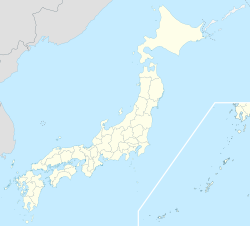Higashimurayama, Tokyo
Higashimurayama
東村山市 | |
|---|---|
 Higashimurayama City Hall | |
 Location of Higashimurayama in Tokyo Metropolis | |
| Coordinates: 35°45′16.6″N 139°28′6.6″E / 35.754611°N 139.468500°E | |
| Country | Japan |
| Region | Kantō |
| Prefecture | Tokyo |
| Area | |
| • Total | 17.14 km2 (6.62 sq mi) |
| Population (April 2021) | |
| • Total | 148,275 |
| • Density | 8,700/km2 (22,000/sq mi) |
| Time zone | UTC+9 (Japan Standard Time) |
| Symbols | |
| • Tree | Zelkova serrata |
| • Flower | Azalea |
| • Bird | White wagtail |
| Phone number | 042-393-5111 |
| Address | 1-2-3 Honcho, Higashimurayama-shi, Tokyo-to 189-8501 |
| Website | Official website |

Higashimurayama (東村山市, Higashi-murayama-shi) is a city located in the western portion of Tokyo Metropolis, Japan. As of 1 March 2021[update], the city had an estimated population of 148,275, and a population density of 8700 persons per km².[1] The total area of the city is 17.14 square kilometres (6.62 sq mi)..
Geography
Higashimurayama is located on the eastern edge of the Sayama Hills, almost in the center of the Musashino Terrace. Most of the city area is flat, except for the northwestern hills.
Surrounding municipalities
Climate
Higashimurayama has a Humid subtropical climate (Köppen Cfa) characterized by warm summers and cool winters with light to no snowfall. The average annual temperature in Higashimurayama is 14.0 °C. The average annual rainfall is 1647 mm with September as the wettest month. The temperatures are highest on average in August, at around 25.7 °C, and lowest in January, at around 2.3 °C.[2]
Demographics
Per Japanese census data,[3] the population of Higashimurayama increased rapidly in the 1950s and 1960s.
| Year | Pop. | ±% |
|---|---|---|
| 1920 | 7,798 | — |
| 1930 | 9,462 | +21.3% |
| 1940 | 11,402 | +20.5% |
| 1950 | 17,993 | +57.8% |
| 1960 | 46,946 | +160.9% |
| 1970 | 96,545 | +105.7% |
| 1980 | 119,363 | +23.6% |
| 1990 | 134,002 | +12.3% |
| 2000 | 142,290 | +6.2% |
| 2010 | 153,365 | +7.8% |
History
The area of present-day Higashimurayama has been inhabited since Japanese Paleolithic times, and numerous remains from the Jōmon, Yayoi and Kofun periods have been discovered. During the Nara period, it became part of ancient Musashi Province. During the Kamakura period, it was the location of the Battle of Kumegawa in 1333.
In the post-Meiji Restoration cadastral reform of April 1, 1889, several villages merged to form Higashimurayama Village in Nishitama District, at that time part of Kanagawa Prefecture. The entire district was transferred to the control of Tokyo Prefecture on April 1, 1893. On April 1, 1942, Higashimurayama Village became the town of Higashimurayama. On April 1, 1964, Higashimurayama was elevated to city status.
Government
Higashimurayama has a mayor-council form of government with a directly elected mayor and a unicameral city council of 25 members. Higashimurayama, collectively with Higashiyamato and Musashimurayama, contributes three members to the Tokyo Metropolitan Assembly. In terms of national politics, the city is part of Tokyo 20th district of the lower house of the Diet of Japan.
Economy
Higashimurayama was formerly an agricultural area, and was noted for its production of sweet potatoes. It is now primary a regional commercial center, and a bedroom community for central Tokyo.
Transportation
Railway
![]() Seibu Railway – Seibu Shinjuku Line
Seibu Railway – Seibu Shinjuku Line
![]() Seibu Railway – Seibu Haijima Line
Seibu Railway – Seibu Haijima Line
![]() Seibu Railway – Seibu Kokubunji Line
Seibu Railway – Seibu Kokubunji Line
![]() Seibu Railway – Seibu Tamako Line
Seibu Railway – Seibu Tamako Line
- Hagiyama - Yasaka - Musashi-Yamato - Tamako
![]() Seibu Railway – Seibu Ikebukuro Line
Seibu Railway – Seibu Ikebukuro Line
![]() Seibu Railway – Seibu Seibu-en Line
Seibu Railway – Seibu Seibu-en Line
![]() Seibu Railway – Seibu Yamaguchi Line
Seibu Railway – Seibu Yamaguchi Line
Highway
- Higashimurayama is not served by any national highways or expressways
Education
Higashimurayama has 15 public elementary schools and seven public middle schools operated by the city government, and three private combined middle/high schools. The city also has two public high schools operated by the Tokyo Metropolitan Board of Education.
Local attractions
- The oldest intact building in Tokyo and one of only two buildings in Tokyo registered as a National Treasure of Japan; the Jizō hall in the temple of Shōfuku-ji.
- Hachikokuyama, a park that is an inspiration for My Neighbor Totoro.
- National Hansen's Disease Museum of Japan
- Site of the 14th century Battle of Kumegawa
- A segment of the ancient Kamakura Kaido highway
Sister cities
Higashimurayama is twinned with the following cities:[4] [5]
| City | Region | Country | Year |
|---|---|---|---|
| Kashiwazaki | 1996 | ||
| Independence | 1978 | ||
| Suzhou | 2005 |
Notable people from Higashimurayama
- Seiichiro Shimizu, Politician
- Ken Shimura, Comedian
- Shoko Aida, Singer
- Miki Nakatani, Actress
- Shōji Satō, Professional Badminton Player
References
- ^ "Higashimurayama city official statistics" (in Japanese). Japan.
- ^ Higashimurayama climate data
- ^ Higashimurayama population statistics
- ^ "Sister Cities". Archived from the original on 5 May 2014. Retrieved 5 May 2014.
- ^ "東村山市ホームページへようこそ!". Higashimurayama City Official Site. June 2007. Archived from the original on 2007-08-21. Retrieved 2007-10-31.
- "Tokyo Metropolitan Government<Welcome to TOKYO Waterworks>" (PDF). Tokyo Metropolitan Government<Welcome to TOKYO Waterworks>. January 2005. Archived from the original (PDF) on 2008-04-10. Retrieved 2007-10-31.
External links
- Higashimurayama City Official Website (in Japanese)



